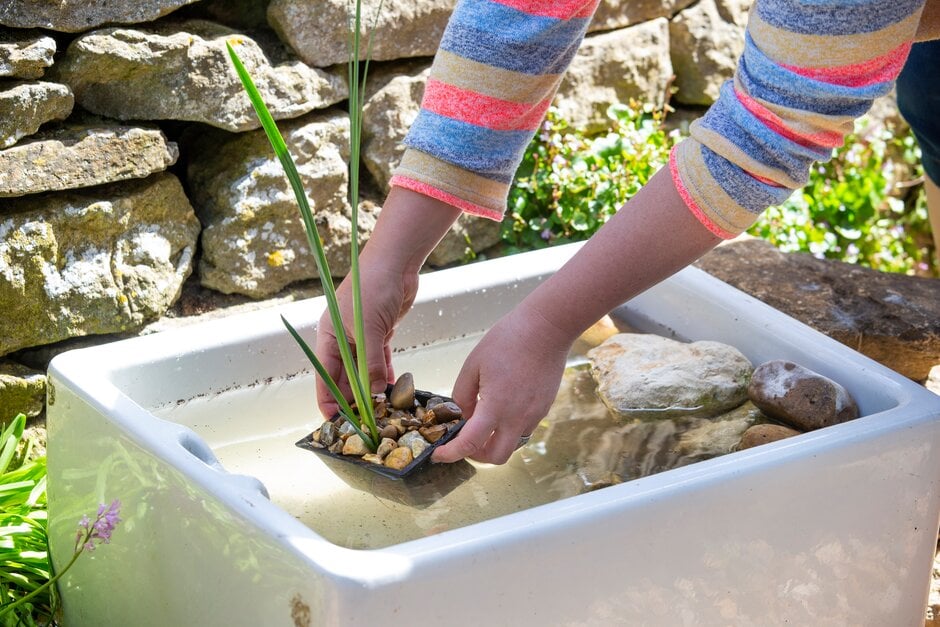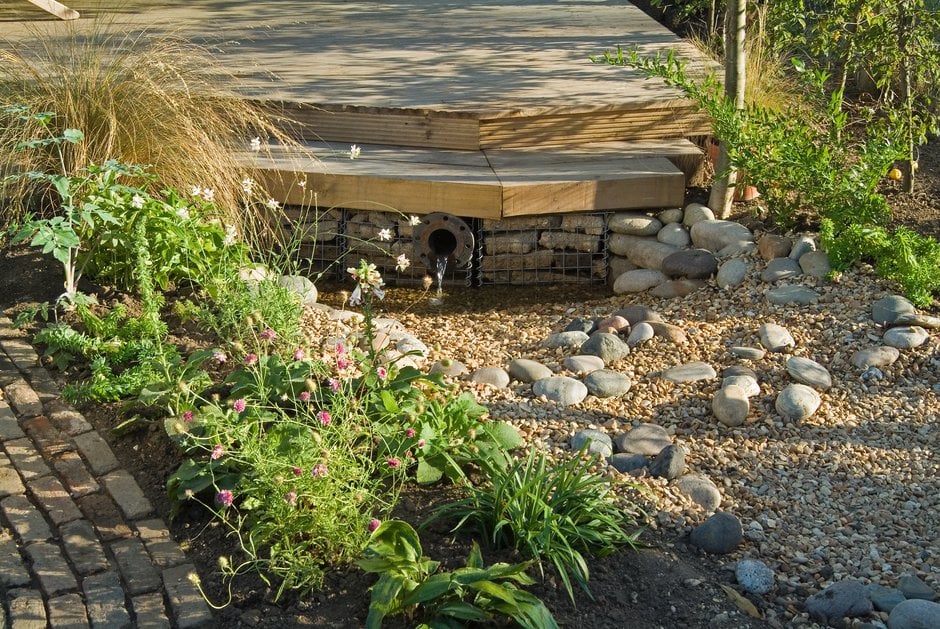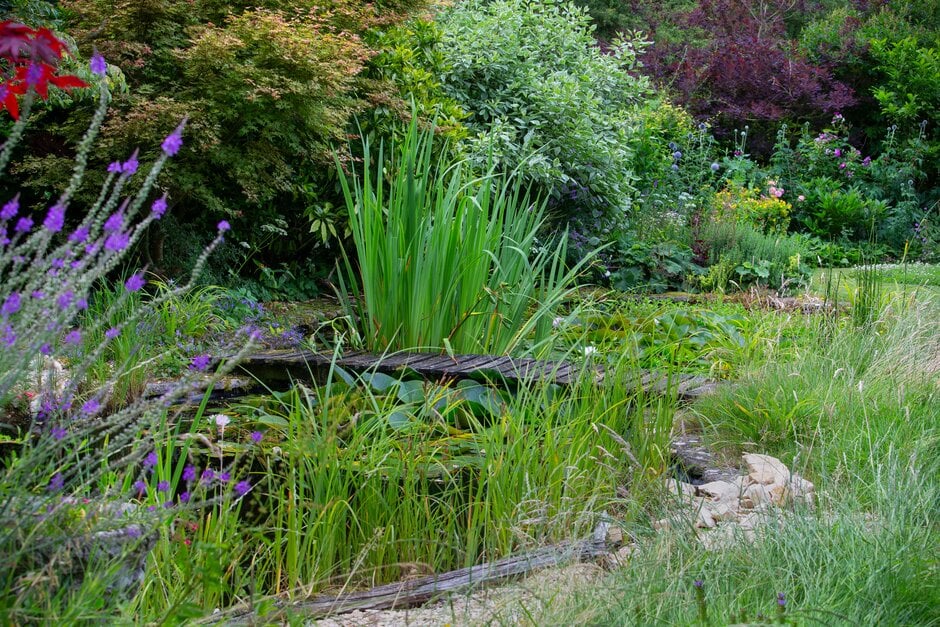Pond algae and blanket weed
Algae can cause discoloured water, green scum at the pond edges or dense mats of green growth under the surface. In warm, sunny weather, these can spread rapidly.
Quick facts
- They thrive in nutrient-rich water, often caused by decomposing plant debris
- Newly filled ponds and those in very sunny locations are particularly prone
- Sunny weather is spring and summer helps pond algae thrive
Jump to
What are pond algae?
There are hundreds of different types of algae that can grow in ponds, some suspended in the water, others spreading across the surface in long fibres. The main signs to look for are:
-
a ‘pea soup’ effect caused by fine algae suspended in water
-
a floating green scum
-
dense growths of hair-like green strands that float under or on the surface or cling to plants at the side of the pond – these are known as blanket weed or silkweed
Apart from turning ponds green, algae can reduce oxygen levels in the water, which can harm pondlife. But algae can also provide valuable shelter and hiding places in a wildlife pond.
Whether or not you take action is a matter of choice – often blanket weed and algae make a temporary appearance in the warmer months, and may not need controlling. In large ponds, they can be difficult to tackle, and in wildlife ponds it’s best to disturb the ecosystem as little as possible.
However, if you like to have clear water in your pond, you may wish to take steps to reduce or discourage algae.
Causes of excess algae
Most ponds will develop algae and blanket weed at some time or another, but they’re particularly common in ponds in a sunny position, with very little planting to provide shade across the surface.
Algae also form when there are too many nutrients in the water, which could be due to:
-
A build-up of organic matter (sludge) on the bottom of the pond
-
Fertiliser leaching into the pond, perhaps from overfeeding a lawn
-
Pond debris, such as fish faeces, fallen leaves and invasive pond weeds
-
Filling or topping up the pond with mains water – use rainwater whenever possible
Improving conditions to deter algae
The best way to discourage algae long term is to remedy the conditions that are helping algae to thrive. Reducing the amount of nutrients entering the pond is crucial:
-
Avoid putting soil in the pond. When adding new plants, make sure they’re in low-nutrient, aquatic compost
-
Take care when applying fertiliser to nearby lawns – only feed if essential and use the minimum effective dose, to avoid any excess nutrients running into the pond
-
Place a net over the pond in autumn to prevent leaves falling in
-
Use rainwater to top up the pond, whenever possible, if the water level drop too low in summer
-
Keep the pond free of fish, as they add nutrients to the water in their faeces. If you do want fish, choose goldfish, orfe or shubunkin. Carp and tench feed in mud and debris at the bottom of pools, so can make the water cloudy. Keep populations in check by occasionally giving excess fish away, or moving them to another garden pond, but never into the wild
Additional changes to discourage algae:
-
Add a fountain or cascade to aerate the water. This can help prevent blue-green algae, but is unlikely to have any effect on other types
-
Install a pond filter or an ultraviolet clarifier to remove algae and other debris from the water
-
Consider introducing ramshorn snails, which eat algae and decaying material. But avoid other water snails, which are less efficient scavengers and, in particular, avoid those with long, pointed shells, as these tend to eat pond plants
Reducing build-ups of algae
However, there several short-term fixes you can also try, but they need to be repeated to keep algae at bay:
-
Physical removal – with blanket weed and other floating algae, scoop them out with a net or a rake, or use a cane to twirl them out
-
Float a mesh bag of barley straw on the pond – about 50g of straw per sq m (1½oz per sq yd) of water surface area is ideal, and should discourage all types of pond algae. Add the straw in spring and remove it when it has turned black (usually about six months later). Sometimes lavender is added to the barley straw for additional effectiveness
-
Add pond dye – Dyofix Pond Black claims to help deter algal growth. By colouring the water black, it deflects ultraviolet rays, so the algae can’t photosynthesise. Surface plants such as waterlilies aren’t affected. It lasts for several months and can be used all year round. Pond Blue is paler, allowing you to see fish and other pondlife beneath the surface
Various other products are available – some appear to be effective only in settling suspended debris, others may give short-term control of free-floating algae. Some claim to control the most troublesome types, such as filamentous algae or blanket weeds, but as there are many different forms of these, you might have to try several products to find one that works in your pond. Treatment needs to be repeated at intervals.
There are currently no chemical treatments available to amateur gardeners.
With large ponds and lakes, it may be best to bring in professionals – go to the National Association of Agricultural Contractors (select ‘find a contractor and 'aquatic weed control’) or Complete Weed Control.
Using ultrasound
Ultrasound systems may be worth considering in large ponds. These have only recently begun to be introduced and need professional installation. The ultrasound device is left permanently in the water and works by shaking apart algal cell wall, killing the algae within a few weeks. Different frequencies may work on different types of algae. For more details, go to WaterLand Management.
Making a new pond
-
Site the pond partly in light shade, not completely in full sun
-
Make it at least 60–75cm (2–2½ft) deep, if possible, to prevent the water warming up too rapidly in sunshine, which speeds up algal growth
-
When choosing plants, aim for about one-third of the pond surface to be covered by aquatic plants, while ensuring there are also sufficient submerged oxygenators. See our guide to pond plants
The colour of the pond liner is unlikely to make much difference when it comes to reducing algae. A pale liner might reduce temperatures, but would increase photosynthesis and thus algal growth, whereas a dark liner may decrease light reflection but increase water temperature, which is known to promote algae.
Also see our guides to making ponds:

How to make a wildlife container pond
Making a new pond

Rain-fed wildlife-friendly pond step-by-step

Wildlife ponds
RHS policy on weeds
See also...
Barley straw datasheet: Centre of Ecology and Hydrology
Supplier of pond treatments: Ecopond
Supplier of pond treatments: Envii
Get involved
The Royal Horticultural Society is the UK’s leading gardening charity. We aim to enrich everyone’s life through plants, and make the UK a greener and more beautiful place.